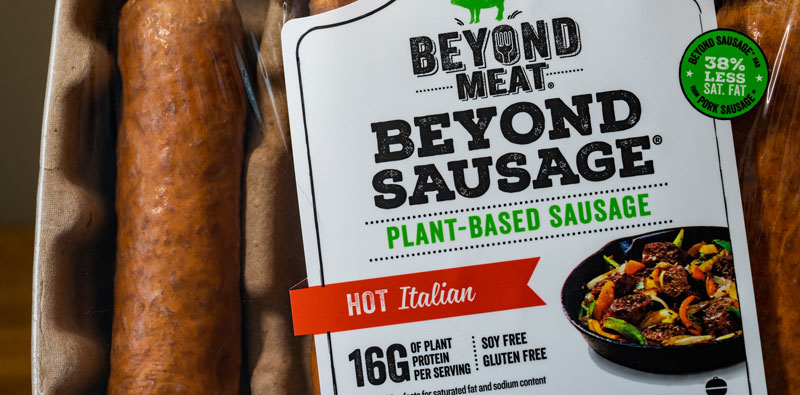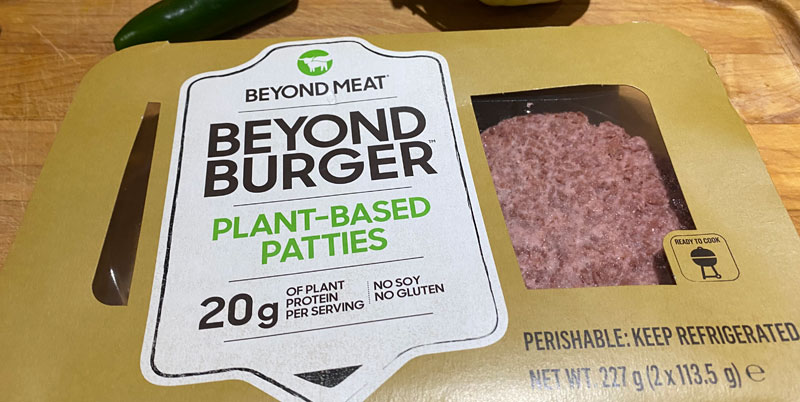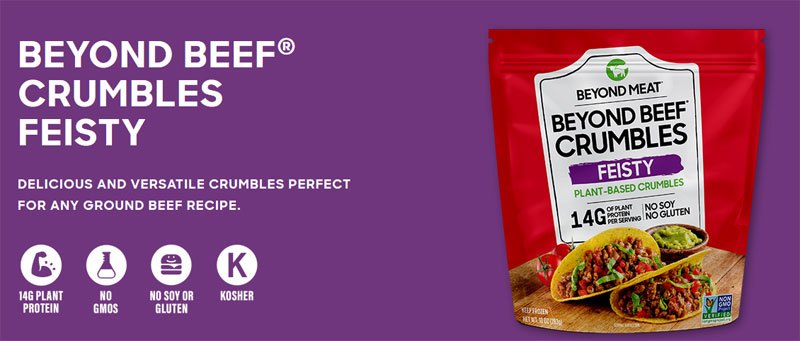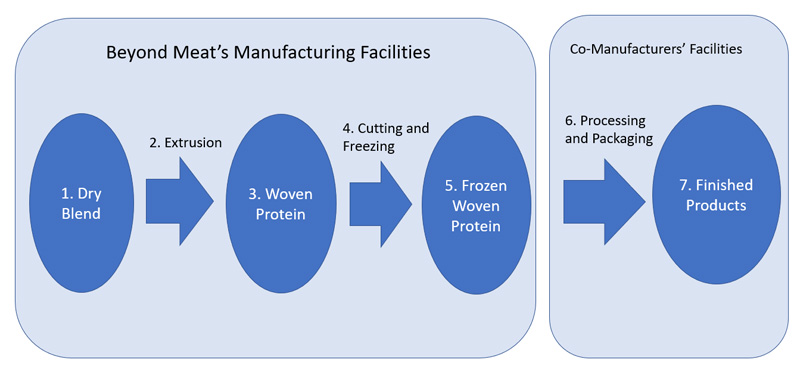
Beyond Sausage. Flickr Image.
Beyond Meat is a food company that provides consumers with plant-based meat alternatives worldwide. The company’s business model offers a healthier and more sustainable alternative to traditional meat products, often associated with negative environmental and health impacts.
Beyond Meat’s products are made from plant-based proteins, oils, and other ingredients and are designed to mimic animal-based meats’ taste, texture, and nutritional profile. The company has attracted a wide range of consumers, including those who follow vegetarian or vegan diets and want to reduce their animal product consumption.
Beyond Meat’s business model is built on innovation, sustainability, and social responsibility, and the company has quickly become a leader in the rapidly growing plant-based food industry.
This article explores the different aspects of Beyond Meat’s business model, including the revenue sources, products, customers and distributors, supply chains, manufacturing processes, sales and marketing, etc.
Let’s take a look!
Please use the table of contents to navigate this page.
Table Of Contents
Definitions And Overview
Revenue And Products
A1. How Beyond Meat Earns Revenue
A2. Products
Sales Channel And Raw Materials
A3. How Beyond Meat Sells Its Products
A4. Supply Chains
Production And Logistics
A5. Manufacturing Process
A6. Distribution
Customer Acquisition
A7. Sales, Marketing And Consumers Reach
Conclusion And Reference
S1. Conclusion
S2. References and Credits
S3. Disclosure
Definitions
To help readers understand the content better, the following terms and glossaries have been provided.
Plant-Based Meat: Plant-based meat is a food product made from plant-based ingredients, such as soybeans, peas, or wheat, that are processed to mimic the taste, texture, and appearance of real meat.
These products are designed to provide an alternative to traditional meat products that are derived from animals. They are often marketed to vegetarians, vegans, and people who are looking to reduce their meat consumption for health or environmental reasons.
Retail Channel: Beyond Meat’s retail channel refers to the various outlets through which the company’s plant-based meat products are sold to consumers for home consumption. These channels include grocery stores, supermarkets, specialty food stores, online retailers, and other retail outlets that carry Beyond Meat’s products.
The company has partnerships with several major retailers, such as Walmart, Target, and Whole Foods, and e-commerce platforms like Amazon and Instacart to make its products easily accessible to consumers across the US and beyond.
Foodservice Channel: Beyond Meat’s foodservice channel refers to the various outlets through which the company’s plant-based meat products are sold to foodservice operators, such as restaurants, cafes, and other food outlets, for use in their menu items.
These channels include food distributors, wholesalers, and direct sales to food service operators. Beyond Meat has partnerships with many food service operators, including major chains like Dunkin’ and Subway, to make its plant-based products readily available to consumers dining out.
Beyond Burger: Beyond Burger is a plant-based burger patty designed to mimic a traditional beef burger’s flavor, texture, and appearance.
Still, it is made entirely from plant-based ingredients such as pea protein isolate, canola oil, and coconut oil. It is a popular vegetarian and vegan option for those who want to enjoy a burger without consuming animal products.
Beyond Beef Crumbles: Beyond Beef Crumbles is a plant-based meat substitute designed to look, taste, and cook like ground beef, but are made entirely from plant-based ingredients such as pea protein, rice protein, and potato starch.
Beyond Beef Crumbles is a popular choice among those who follow a vegan or vegetarian diet and those looking to reduce their consumption of animal products. They can be used in various recipes in place of ground beef, such as tacos, spaghetti sauce, chili, and more.
A1. How Beyond Meat Earns Revenue
Beyond Meat generates revenue primarily through the sale of its plant-based meat products. The company sells its products in grocery stores, restaurants, and other food service outlets.
Beyond Meat also generates revenue through licensing agreements and partnerships with other companies in the food industry. Additionally, the company has received funding from investors and has gone public, providing additional revenue sources.
Overall, Beyond Meat’s revenue is driven by the growing consumer demand for plant-based meat alternatives and the company’s ability to innovate and expand its product offerings.
A detailed discussion of Beyond Meat’s revenue is presented in this article: Beyond Meat Revenue.
A2. Beyond Meat’s Products
Beyond Meat offers its plant-based meat products across three main platforms: beef, pork and poultry.
These major platforms are further divided into two categories: (1) Ready-To-Cook (“Fresh”) and (2) Ready-To-Heat (“Frozen”).
Ready-To-Cook (“Fresh”)
Beyond Burger
Under the ready-to-cook category, which the company refers to as a “fresh” platform, you can find several offerings.
For example, the Beyond Burger, Beyond Sausage, and Beyond Beef are some popular products in the ready-to-cook segment.
In addition, the Beyond Breakfast Sausage, Beyond Fried Chicken, and Beyond Meatball also fall under the ready-to-cook section. These plant-based meat products have been gaining popularity as it takes less than 10 minutes to prepare.
Ready-To-Heat (“Frozen”)
Beyond Beef Crumbles
Within the ready-to-heat or “frozen” segment, Beyond Meat offers only one selection, which is the Beyond Beef Crumbles.
Like its counterparts in the ready-to-cook section, the Beyond Beef Crumbles also has been gaining traction among consumers’ appetites as it offers simplicity and nutritional ingredients packed with 14 grams of protein and 1 gram of fiber per serving.
Moreover, Beyond Beef Crumbles contains no soy and GMO products and is certified Kosher and Halal.
A3. How Beyond Meat Sells Its Products
Beyond Meat sells its products through two major distributor channels. They are:
(1) Retail, and,
(2) Foodservice
The definitions of Beyond Meat’s retail and foodservice channels are available here: Retail Channel and Foodservice Channel. Beyond Meat has a powerful presence at some of the leading food retailers in the United States.
As of Sept 30, 2023, Beyond Meat has approximately 33,000 retail outlets (excluding Beyond Meat Jerky) in the U.S. alone and about 36,000 retail outlets outside of the U.S., according to its 3Q 2023 quarterly filings.
Net revenue from sales through retail channels alone reached nearly $300 million in fiscal 2022. This figure includes sales from the U.S. and globally.
Some of Beyond Meat’s largest retailers carrying the company’s products include Walmart, Kroger, Target, Whole Foods Markets, Sam’s Club, and Costco. In 2020, Costco accounted for approximately 13% of Beyond Meat’s gross revenue, making it one of its largest customers.
On the other hand, Beyond Meat also distributes its products directly to restaurants and food service outlets. By the end of fiscal 2022, Beyond Meat’s products are available in over 42,000 restaurants and foodservice outlets in the U.S. alone and 26,000 more outlets outside the U.S.
While Beyond Meat’s retail sales have held firm post-pandemic, its foodservice revenue has remained lower, largely due to COVID-19 disruptions.
As of the end of fiscal 2022, Beyond Meat’s net revenues from sales through restaurant and foodservice outlets clocked only $123 million, a decline of 20% or $30 million over the peak in 2019.
Other than the U.S., Beyond Meat also has been slowly expanding its product offerings in the international market. The company uses mainly distributors to sell its products in the international market. As of fiscal 2022, Beyond Meat’s international market revenue reached $115 million, representing a year-on-year decline of 20%.
A4. Supply Chain
The discussion of Beyond Meat’s business model will be incomplete without going into the topic of the supply chain.
Beyond Meat’s supply chain is one of the most critical components of the business because it is through the supply chain that the company gets most of its raw materials to manufacture its products.
Generally, the main ingredient in Beyond Meat’s plant-based meat products is pea protein. The company acquires pea proteins from a number of suppliers for its fresh as well as frozen products.
According to the 2022 annual report, Beyond Meat uses suppliers such as Roquette Frères to supply the required plant-based protein for its products. Beyond Meat generally uses multi-year supply agreements, which usually extend from 1 to 3 years, to keep a constant stream of supplies for the needed raw materials.
Other than pea protein, another critical ingredient that Beyond Meat needs to produce its products is plant-based flavors. Plant-based flavors are flavors developed by Beyond Meat, but the raw materials used in making the flavors are sourced from 3rd parties.
In this aspect, Beyond Meat does not manufacture the flavors. Instead, it’s being produced by vendors who have the flavors according to a formula developed by Beyond Meat.
These flavors are then qualified through a lab analysis to ensure quality and manufacturability. According to Beyond Meat, the ingredients used for producing the flavors are readily available from many suppliers. They will not drastically affect the company’s operation in the event of a supply cut from a vendor.
A5. Manufacturing Process
Once Beyond Meat successfully secures the raw materials, such as the pea protein and flavors, the company will begin manufacturing its plant-based products.
During the manufacturing process, Beyond Meat relies on its manufacturing facilities and 3rd parties manufacturing facilities, which the company refers to as co-manufacturers.
The following diagram extracted from Beyond Meat’s 2022 annual report summarizes the manufacturing process:
Beyond Meat manufacturing steps
Manufacturing processes that are performed in Beyond Meat’s facilities :
1. A dry blend is first performed to combine plant protein in the manufacturing facilities.
2. An extrusion is then performed on the dry blend to add water and steam.
3. A combination of steps, such as heating, cooling, and variations of pressure, is executed here to weave together the blended proteins.
4. The formed woven protein is then cut into pieces to expedite the freezing process and assist in the final manufacturing process.
5. The final products are frozen woven protein, which will be used as the basis of all Beyond Meat’s products.
Manufacturing steps that are performed in Beyond Meat’s co-manufacturers facilities :
6. The frozen pieces of woven protein are then passed to Beyond Meat’s co-manufacturers for further processing. During this step, flavors and other ingredients are added and combined.
7. The final step in the co-manufacturers facilities is to package the products and prepare them to be shipped to distributors and customers.
In addition to its production facilities, Beyond Meat uses co-manufacturers in various locations in the United States, Canada, the Netherlands, and China. Beyond Meat registered a new subsidiary, Beyond Meat (Jiaxing) Food Co., Ltd., in the Zhejiang Province in China in 2Q 2020.
A6. Distribution
Beyond Meat relies partially on its co-manufacturers to manufacture some plant-based meat products. As such, the company’s final products are usually shipped out from these co-manufacturers facilities by 3rd-party logistic providers.
Beyond Meat’s products are transferred and stored in cold-storage facilities during the distribution step. Some of the products are also shipped directly to the customers.
A7. Sales, Marketing, and Consumers Reach
The final topic in the discussion of Beyond Meat’s business model is how the company markets its products and builds its brand so that more people know Beyond Meat’s unique approach to producing its flagship plant-based meat products.
Sales
Beyond Meat has a 36-person strong sales team as of Dec 31, 2020. The sales team is organized into four divisions: retail, foodservice, international, and strategic partnerships.
These experienced sales personnel collaborate closely with a network of brokers and distributors with access to accounts across the U.S., Canada, and globally to support and drive sales for the company.
Field Marketing Representatives
Other than a sales team, Beyond Meat also created a team of field marketing representatives. The role of the field marketing representatives is to provide samples of Beyond Meat’s products directly to consumers at stores and events.
Other than working at stores and events, Beyond Meat’s field marketing representatives also work together with food trucks to support consumer sampling and content creation as well as media, influencers, and activists.
The 2019 annual report shows more than 2,000 such events, with approximately 428,000 samples distributed. These field events help promote consumers’ awareness of Beyond Meat’s core missions and drive sales for the company’s plant-based products.
Digital Marketing and Social Media
Beyond Meat has also been actively engaging consumers via social and digital media to drive brand awareness and interest in the company’s plant-based meat products.
In this aspect, Beyond Meat has partnered with a network of brand ambassadors to develop a strong following of celebrities from the world of sports and entertainment who share the company’s core values and missions.
Aside from brand ambassadors, Beyond Meat also uses social media platforms such as Facebook, Instagram, TikTok, and Twitter for online collaboration.
As of Dec 31, 2020, the company has 440,000 Facebook followers, 970,000 Instagram followers, more than 118,000 Twitter followers, and roughly 93,000 LinkedIn followers.
Conclusion
Beyond Meat is a new force to be reckoned with in the food industry. The company has been one of the fastest-growing food companies in the U.S. and possibly the world.
The company’s core mission is to address human health, climate change, resource conservation, and animal welfare concerns.
Beyond Meat’s intact and effective business model has propelled it to greater heights.
While still unprofitable and having negative free cash flow, my opinion is that the company will someday achieve success with its revolutionary plant-based meat products.
References and Credits
1. All financial data presented in this article were obtained and referenced from Beyond Meat’s quarterly and annual statements, presentations, press releases, SEC filings, etc., which are available in Beyond Meat financial reports.
2. Featured images in this article are used under Creative Common Licenses and obtained from the following source:
a. Flying Puffin
b. Tony Webster
c. Christoph Scholz
d. Beyond Beef Crumbles
Disclosure
References and examples such as tables, charts, and diagrams are constantly reviewed to avoid errors, but we cannot warrant the total correctness of all content.
The content in this article is for informational purposes only and is neither a recommendation nor a piece of financial advice to purchase a stock.
If you find the information in this article helpful, please consider sharing it on social media and provide a link to this article from any website so that more articles like this can be created.
Thank you!




the great insight about the business opportunity thank you for sharing with us.
visit us: https://www.beckandbulow.com